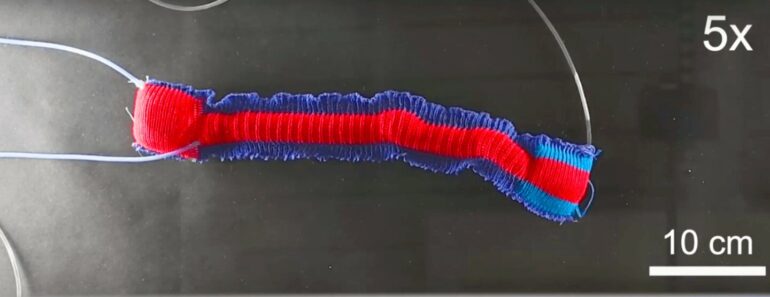Soft robotics have several key advantages over rigid counterparts, including their inherent safety features—soft materials with motions powered by inflating and deflating air chambers can safely be used in fragile environments or in proximity with humans—as well as their flexibility that enables them to fit into tight spaces. Textiles have become a choice material for constructing many types of soft robots, especially wearables, but the traditional “cut and sew” methods of manufacturing have left much to be desired.
Now, researchers at the Harvard John A. Paulson School of Engineering and Applied Sciences (SEAS) have established a new approach for additively manufacturing soft robotics, using a 3D knitting method that can holistically “print” entire soft robots. Their work is reported in Advanced Functional Materials.
“The soft robotics community is still in the phase of seeking alternative materials approaches that will enable us to go beyond more classical rigid robot shapes and functions,” says Robert Wood, senior corresponding author on the paper, who is the Harry Lewis and Marlyn McGrath Professor of Engineering and Applied Sciences at SEAS.
“Textiles are appealing since we can radically tune their structural properties by choice of their constituent fibers and how those fibers interact with each other,” Wood says.
“Using ‘cut and sew’ methods, you need to manufacture large sheets of textile material that you then cut into patterns that are assembled by stitching or bonding—and this typically involves a high level of human labor,” says Vanessa Sanchez, first author on the paper and a former Ph.D. student in Wood’s lab. “Every seam adds costs, and potential points of failure. For manufacturing complex robotic devices, this can be a big challenge.”
Sanchez was intrigued by the concept of 3D knitting, which can produce seamless articles of clothing with little material waste. She wondered if the method could be adapted to create textile-based soft robots.
The team acquired a vintage punch card knitting machine and Sanchez connected with knitting experts from the Rhode Island School of Design and Parsons School of Design and Fashion Institute of Technology.
To automate the knitting process, Sanchez and the team also needed to develop software that could direct the knitting equipment—machines often several-decades old—to make complex structures out of various types of yarns. “In one instance, I had to trick the machinery—using a software program—into thinking that my computer was a floppy disk,” Sanchez says. After initial experiments were promising the team moved to a more modern, automated machine.
James McCann, an Assistant Professor at the Carnegie Mellon Robotics Institute, collaborated on the software. “The team wanted to develop and characterize a wide range of soft actuators—they weren’t just building one pattern, they were building a whole set of parametric patterns,” McCann says. “This is hard to do with traditional knitting design software, which is generally focused on developing single outputs by hand instead of easily-adjustable parametric families of outputs.”
To create a workaround, the team described the 3D patterns using a “knitout” file format—a knitting description written in general-purpose programming languages—and then developed code to translate those knitout descriptions to run on their desired knitting machine.
“The cool thing about developing parametric patterns in a generic knitting format like knitout is that other groups with different types of knitting machines can use and build on the same patterns, without extensive translation effort,” McCann says.
After setting up their 3D knitting process, Sanchez and collaborators conducted a series of experiments to, for the first time, create an extensive library of knowledge about the way various knitting parameters impact mechanical properties of the resulting material. Testing 20 different combinations of yarn, structure, and more, the team characterized how varied knit architectures impact folding and unfolding, structural geometry, and tensile properties.
Using combinations of these structures, they demonstrated many different knit robot prototypes, including various types of gripper devices with bending and grasping appendages, a multi-chamber claw, an inchworm-like robot, and a snake-like actuator capable of picking up objects much heavier than the device itself.
“We wanted to create a library for engineers to draw from to develop a variety of soft robots, so we characterized the mechanical properties of many different knits,” Sanchez says. “3D knitting is a new way of thinking about additive manufacturing, about how to make things that could be reconfigured or redeployed. There are already industrial machines to support this type of manufacturing—with this initial step, we think our approach can scale and translate out of the lab.”
“I envision that programmable textiles will have a similar impact on how soft robots are made as fiber-reinforced composites have had on the construction of high-performance aircraft and automobiles,” Wood says.
More information:
Vanessa Sanchez et al, 3D Knitting for Pneumatic Soft Robotics, Advanced Functional Materials (2023). DOI: 10.1002/adfm.202212541
Provided by
Harvard John A. Paulson School of Engineering and Applied Sciences
Citation:
Additively manufacturing soft robots could reduce waste, increase performance (2023, May 17)



